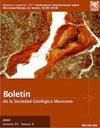Use of sediments and soils (paleosols) in construction fills of La Joya archaeological site, Veracruz, Mexico: micromorphological evidence
IF 0.4
4区 地球科学
Q4 GEOLOGY
引用次数: 0
Abstract
In this paper, we study the materials used for the construction of earthen structure in the La Joya archaeological site, on the Gulf of Mexico coast, built on top of a paleodune, from the Late Preclassic (400 BC) to the Classic period (AD 100-1000). The first constructions arise around 100 BC, on a paleodune top rising slightly above the surrounding alluvial terraces of the Jamapa river; then it grows into a 15-ha monumental compound. The total construction volume reaches 250,000 m3, all made of earth, surrounded by large artificial water pounds (reservoirs). To understand the kind of components found in the structures and their provenance, we compare the micromorphological features of the materials from the earthen constructions with the sediments and paleosols located in the surrounding areas. Samples were taken from the fills of three first building stages, as well as from a natural soil profile and the natural paleosol horizons found beneath the structures. Micromorphological features found in fills permit to establish the correlation between them and their parent material. The fills from the first stage of construction have fragments of a Btb horizon, mixed with an A horizon, compacted and crushed, in which abundant artifacts are identified. However, these artifacts were not intentionally incorporated to the fills, but had been accumulated on the pre-occupation A horizon as residential and agriculture trash. Particular attention was paid to a gley material occurring in the third building stage, that was believed to come from the sediments accumulated in the original borrow pits transformed into water reservoirs, enclosing the main architectural compound. These reservoir fills share properties of the natural sediments and paleosols but transformed by the waterlogging conditions. In consequence, these materials are interpreted as a case of anthropogenic pedogenesis, where the gley micromorphology indicates waterlogging conditions, but in artificially made reservoirs, as they do not have dark organic sediments that would result of the vegetation typical of a natural pond in a humid tropical environment.沉积物和土壤(古土壤)在墨西哥韦拉克鲁斯拉霍亚考古遗址建筑填充物中的使用:微形态学证据
在本文中,我们研究了墨西哥湾沿岸La Joya考古遗址中用于建造土结构的材料,该遗址建于古沙丘之上,从前古典主义晚期(公元前400年)到古典主义时期(公元100-1000年)。第一批建筑出现在公元前100年左右,位于古沙丘顶部,略高于周围的Jamapa河冲积阶地;然后它就长成了一个15公顷的纪念性建筑群。总建筑量达到25万立方米,全部由泥土制成,周围有大型人工水磅(水库)。为了了解在结构中发现的成分及其来源,我们将土建筑材料的微观形态特征与周围地区的沉积物和古土壤进行了比较。样本取自三个第一建造阶段的填土,以及在结构下方发现的天然土壤剖面和天然古土壤层。在填充物中发现的微观形态特征允许建立它们与其母体材料之间的相关性。施工第一阶段的填土有Btb层的碎片,与a层混合,压实并压碎,其中发现了大量的人工制品。然而,这些文物并不是故意融入填充物中的,而是在占领前的A地平线上作为住宅和农业垃圾堆积起来的。特别注意的是第三个建筑阶段出现的一种潜育物,据信它来自原始取土坑中积累的沉积物,这些取土坑被改造成蓄水池,包围着主要的建筑群。这些储层填充物具有天然沉积物和古土壤的共同特性,但受到内涝条件的影响。因此,这些材料被解释为人为成土的一种情况,潜育微形态表明了内涝条件,但在人工建造的水库中,因为它们没有深色有机沉积物,这将是潮湿热带环境中天然池塘典型植被的结果。
本文章由计算机程序翻译,如有差异,请以英文原文为准。
求助全文
约1分钟内获得全文
求助全文
来源期刊
CiteScore
1.40
自引率
12.50%
发文量
34
审稿时长
50 weeks
期刊介绍:
The Boletín de la Sociedad Geológica Mexicana is a completely free-access electronic journal published semi-annually that publishes papers and technical notes with its main objective to contribute to an understanding of the geology of Mexico, of its neighbor areas, and of geologically similar areas anywhere on Earth’s crust. Geology has no boundaries so we may publish papers on any area of knowledge that is interesting to our readers.
We also favor the publication of papers on relatively unfamiliar subjects and objectives in mainstream journals, e.g., papers devoted to new methodologies or their improvement, and areas of knowledge that in the past had relatively little attention paid them in Mexican journals, such as urban geology, water management, environmental geology, and ore deposits, among others. Mexico is a land of volcanos, earthquakes, vast resources in minerals and petroleum, and a shortage of water. Consequently, these topics should certainly be of major interest to our readers, our Society, and society in general. Furthermore, the Boletín has been published since 1904; that makes it one of the oldest scientific journals currently active in Mexico and, most notably, its entire contents, from the first issue on, are available online.

 求助内容:
求助内容: 应助结果提醒方式:
应助结果提醒方式:


